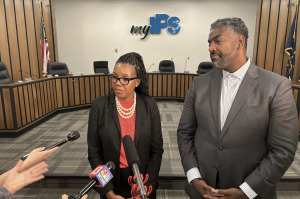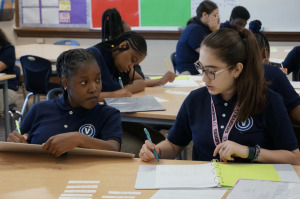
IPS moving ahead with part of Rebuilding Stronger plan
Indianapolis Public Schools plans to implement only part of its massive Rebuilding Stronger overhaul after the school board failed to place an operating referendum on the upcoming May ballot.

Indianapolis Public Schools plans to implement only part of its massive Rebuilding Stronger overhaul after the school board failed to place an operating referendum on the upcoming May ballot.

IPS is the first district in the state to partner with the National Education Equity Lab to allow Crispus Attucks High School students to enroll in college-level courses at the country’s top universities.

As students in grades 3-8 prepare to take the ILEARN again beginning in April, the district is focusing on tactics to continue its progress and reach that goal, with the help of federal COVID relief funding.

The business advocacy group questioned how the effort would improve academic performance and why students in the district’s Innovation charter schools wouldn’t receive an equal portion of the funding.

A revised revenue-sharing plan from Indianapolis Public Schools to increase the amount of funding affiliated charter schools would receive from a potential tax hike is still inadequate, charter-friendly groups say.

The shift in the board’s makeup comes at a critical moment, right as the district implements its Rebuilding Stronger revitalization plan adopted unanimously by the board last year.
The complaints claim that the school board failed to alert the state Department of Education of its available buildings slated for closure within 10 days of voting to close the schools on Nov. 17, as required by law.

A statewide charter school group has filed a complaint with the Indiana Attorney General’s Office against Indianapolis Public Schools alleging that the district failed to comply with a state law requiring it to offer unused school buildings to charter schools for $1. The complaint stems from the district’s passage of its reorganization plan, known as […]

IPS heads into the new year amid public disagreement between district officials and some charters over how much funding from the referendum should be split up between different schools, if voters approve it.

If approved by voters, the referendum will authorize the district to issue bonds, which will yield an estimated $410 million for construction projects.
The announcement early Tuesday came a day after the school board adopted his recommendation to end elementary school choice in a controversial vote that spurred parent opposition.

The Perry Township school board voted on Monday to end school choice for elementary students effective next school year to help alleviate a severe bus driver shortage, despite significant opposition from parents.

Parents and their children argued in a public comment session on Monday that it would be better for the district to improve driver-recruitment efforts rather than force hundreds of students to attend a new school next year.

Dozens of charter school parents and students packed the board room before the vote and called on the board to share more of the referendum money.

Leaders from 52 charter schools argued that the annual amount from the tax proposal IPS has offered to share with its innovation network charters would still leave a big funding gap between charter students and those in the district’s traditional public schools.

The six planned school closures follow the IPS board’s vote to adopt the Rebuilding Stronger plan last week.

Indianapolis Public Schools will close six buildings and reconfigure elementary and middle school grades throughout the district following the school board’s approval of the plan Thursday night.

Hope Hampton, a small business owner who previously worked as a dean and school counselor, received endorsements and significant campaign donations from charter-friendly groups and their affiliated political action committees.

Potential stipends as high as $10,000 might not be enough to stave off a significant number of teacher departures.

The IPS Rebuilding Stronger plan—an attempt to address declining enrollment amid charter school growth—would leave multiple school buildings open for charter schools to potentially occupy.